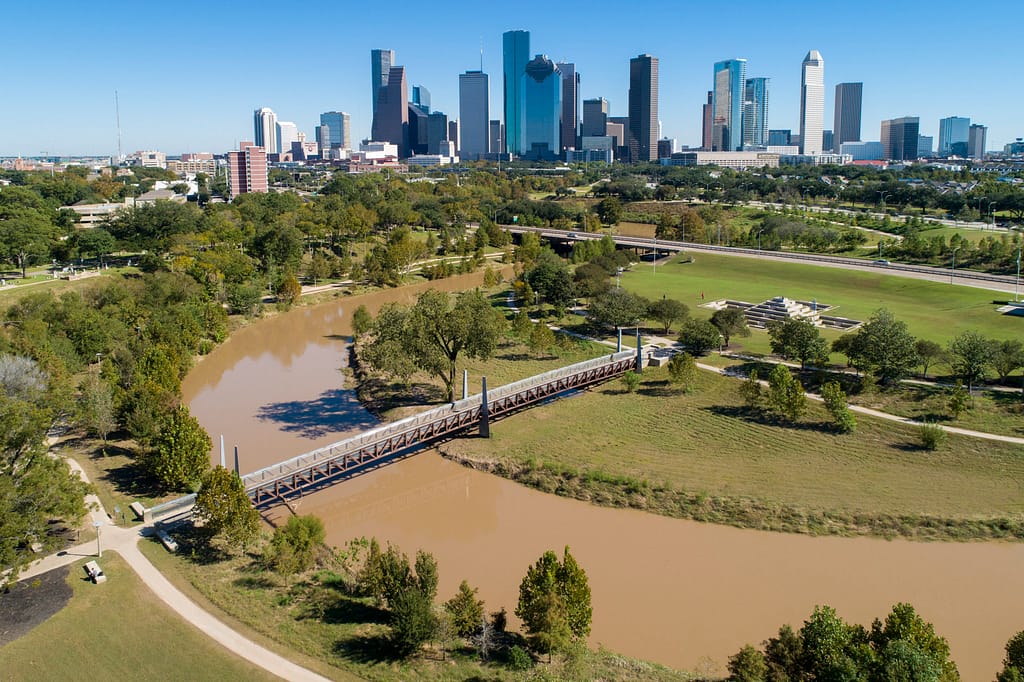Houston’s early growth and success are deeply tied to a natural feature that predates the city itself – Buffalo Bayou. This winding waterway, which cuts through the heart of the region, played a pivotal role in the establishment and expansion of Houston from its founding days to its rise as a major city.

1. The Bayou as a Transportation Route
In the early 19th century, Buffalo Bayou served as a critical transportation route for early settlers. Before modern infrastructure, rivers and bayous were the primary means of moving goods and people. As Houston’s founders, Augustus and John Allen, scouted for a suitable location to establish the city in 1836, they were drawn to the area due to Buffalo Bayou’s navigable waters.
Unlike many other Texas cities that relied on railroads, Houston’s proximity to the Gulf of Mexico via Buffalo Bayou gave it a significant advantage. The bayou provided a natural waterway that allowed boats to carry cotton, timber, and other goods downriver to Galveston Bay and beyond, creating a direct link to the global market.
This ease of access attracted settlers, investors, and traders to the region, setting the stage for Houston to become a commercial hub.
2. Founding of the Port of Houston
The significance of Buffalo Bayou was fully realized with the founding of the Port of Houston. In 1841, Houston was officially designated as a port city, largely thanks to the navigability of the bayou. This designation sparked the development of trade routes that would turn Houston into a bustling center of commerce.
Over the decades, as ships grew in size and trade demands increased, Buffalo Bayou underwent significant modifications. Dredging operations deepened the channel, and docks and warehouses were constructed along its banks. By 1914, the completion of the Houston Ship Channel – an extension of Buffalo Bayou – transformed the port into one of the busiest in the United States, further cementing the city’s role in national and international trade.

3. The Bayou’s Role in Industrial Growth
Buffalo Bayou didn’t just serve as a transportation route – it also supported Houston’s industrial growth. The area surrounding the bayou attracted early industries, including cotton mills, sawmills, and oil refineries. By providing easy access to transportation for raw materials and finished goods, the bayou played an essential role in the establishment of manufacturing and processing plants.
In particular, the discovery of oil at Spindletop in 1901 led to the development of oil refineries along the bayou, making Houston a key player in the growing energy industry. Buffalo Bayou’s banks became dotted with refineries and petrochemical plants, forever changing the landscape of the city.
4. Environmental Impact and Flooding Challenges
While Buffalo Bayou was crucial to Houston’s development, it also presented challenges. The bayou’s natural tendency to flood became a growing concern as the city expanded. Devastating floods in 1935 and 1940 highlighted the need for flood control measures, prompting the construction of reservoirs and levees.
Despite these efforts, the risk of flooding remains a constant challenge, particularly as urbanization has altered the bayou’s natural floodplain. In recent years, initiatives have focused on environmental restoration and flood mitigation to protect both the bayou and the city from the impacts of extreme weather events.
5. Buffalo Bayou Today: A Cultural and Environmental Treasure
In modern times, Buffalo Bayou has undergone a transformation from a bustling industrial artery to a treasured green space. The Buffalo Bayou Park, which stretches for 160 acres through the heart of the city, offers residents and visitors a chance to enjoy nature in an urban setting. Walking trails, public art installations, and recreational opportunities have made the bayou a symbol of Houston’s balance between progress and preservation.
Efforts to restore the bayou’s natural ecosystems have also gained momentum, as local organizations work to improve water quality, plant native species, and create habitats for wildlife. These initiatives aim to ensure that Buffalo Bayou continues to serve as a vital resource for the city’s environmental and cultural well-being.
The Lifeline of Houston’s Growth
Buffalo Bayou’s role in shaping Houston’s early development cannot be overstated. From facilitating trade and industrial expansion to creating a connection between the city and the wider world, this historic waterway was the lifeblood of the city’s rise. Today, Buffalo Bayou remains an integral part of Houston’s identity, reflecting both the city’s industrial roots and its commitment to sustainability and preservation.
As Houston continues to grow and evolve, Buffalo Bayou will undoubtedly remain a central feature, reminding future generations of the vital role this natural waterway played in the city’s rich history.